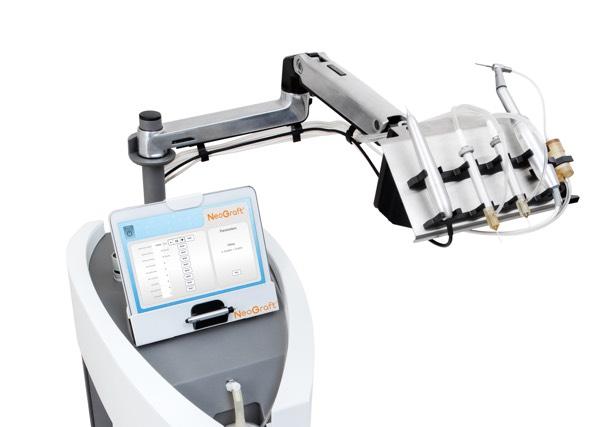
Robotic Device for Assisting Follicular Unit Extraction (FUE) Hair Transplantation
State of the art, ultra-refined follicular unit hair transplant surgery offers hair loss suffering men and women the potential to restore the appearance of a full head of hair. Today, the gold standard for surgical hair restoration is follicular unit transplantation (FUT). Two popular donor harvesting techniques or sub-types of FUT include strip excision (removing a strip of tissue from bald resistant areas on the sides and back of the scalp and microscopically preparing follicular units for transplantation) and follicular unit excision (formerly know as follicular unit extraction) or FUE(harvesting follicular units one by one from bald resistant donor areas including the scalp, body, beard, etc.). FUE has become increasingly popular due to patient demand for a less invasive procedure and reduced scarring. Learn more about FUE hair transplant surgery versus FUT via strip excisionand which one is right for you.
Because FUE hair transplant surgery is a slow and labor-intensive process, new and innovative extraction devices are often developed for the purpose of making FUE easier for the surgeon to perform while maximizing session sizes and hair growth (yield) for the patient. The NeoGraft Hair Transplant Machine is one such device. But, can the NeoGraft hair transplant system really revolutionize the follicular unit excision procedure?
What is the NeoGraft and How Does it Work?
NeoGraft is the American name of the Medicamat machine, which was developed in France with the lofty goal of making FUE extractions faster and reducing follicular transection (severing of the hair bulb). The NeoGraft system is not a fully automated device but rather a machine consisting of an adjustable, slowly rotating motorized punch and a pneumatic pressure suction device that reportedly allows each follicular unit to slide in and out smoothly and uniformly. The “no touch” NeoGraft method of extraction allows up to 600 grafts to be harvested per hour, theoretically exerting less force than manual extraction using forceps. Once extracted, follicular units are then sucked through a series of tubes into a collection canister where they are misted to keep them moist while they await implantation.
The system offers hair restoration surgeons two options for implanting the follicular unit grafts. They can be auto-loaded into an implantation cannula and then inserted into the recipient site pneumatically using reverse air pressure or the physician has the option of manually implanting the grafts if he or she so desires.
NeoGraft Hair Transplant Advantages and Disadvantages
According to NeoGraft’s website, the system offers patients all of the benefits of follicular unit excision while providing physicians with the added benefits of: a short learning curve, fast harvesting, consistent high quality grafts, improved reproducible outcomes, and low overhead costs per case.
Additional advantages to the patient over manual FUE are also said to include the ability to harvest and transplant more grafts safely, reduced torsional forces on the grafts during extraction. and lower cost.
However, some expert FUE practitioners have expressed concerns over the mechanical functions of NeoGraft. The machine’s spinning punch, while facilitating graft removal, may actually subject the follicular unit grafts to unnecessary and detrimental torsional forces and/or overheating. In addition, due to the potential for follicular units to be naturally wider or splayed at one end, there is also a possibility for transection as they are forced through the rotating punch. Finally, there are concerns that the route that the grafts take as they are moved through the suction device and into the collection canister may expose them to further damage through rapid desiccation (dehydration). Dehydration of the follicles during surgical hair restoration is one of the primary causes of poor hair growth.
Questionable Marketing of the NeoGraft to Inexperienced Surgeons and Technicians
The NeoGraft hair transplant system has been aggressively marketed to neophyte physicians and inexperienced technicians. This is clearly evident in the following quote taken directly from the company’s website, “The FUE procedure using NeoGraft is not so dependent on the skill of the doctor”. Since no automated device or machine can adapt or make critical decisions during surgical procedures like a skilled and experienced physician, there is a major concern that many patients who undergo FUE with an inexperienced physicians/technician using the NeoGraft will be left with poor results.
Conclusion
Today, NeoGraft has been successfully adopted by a number of highly skilled surgeons around the world but concerns linger about its efficacy, especially when implemented by unskilled and/or inexperienced practitioners.
Ultimately, the NeoGraft Automated Hair Transplant System can be a valuable tool in the right hands but a tool is only as effective as the person using it. Thus, the quality of hair transplant results relies much more on the skill and experience of the surgeon and his/her staff than on which tool they use.











